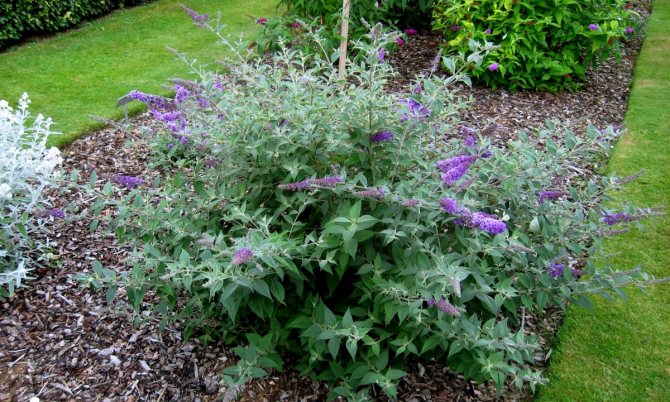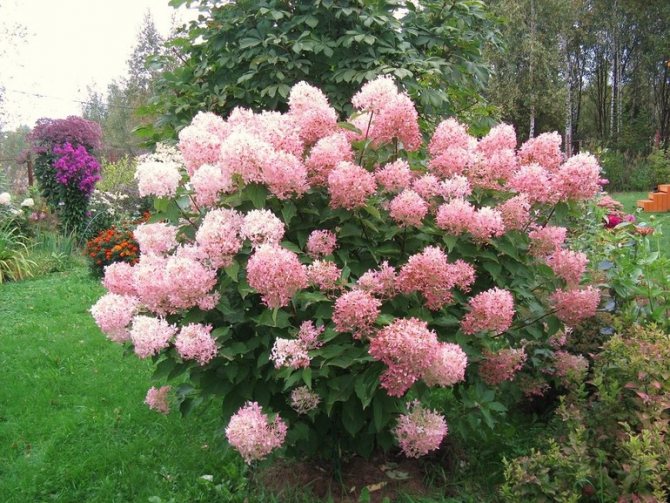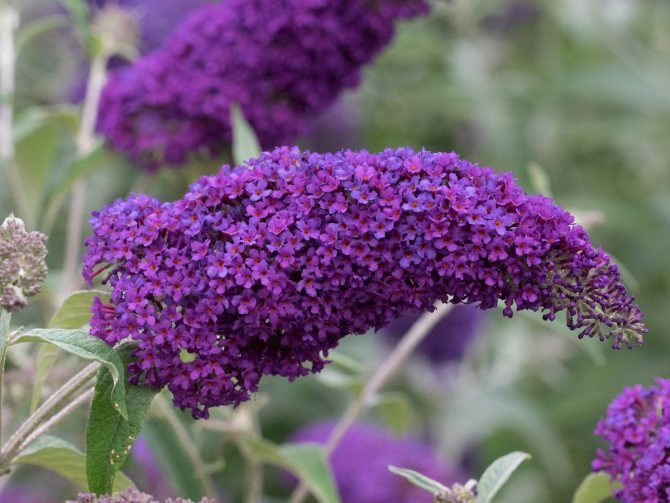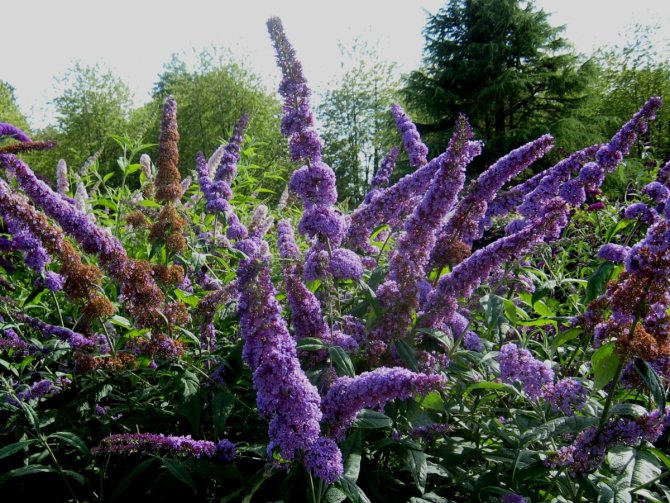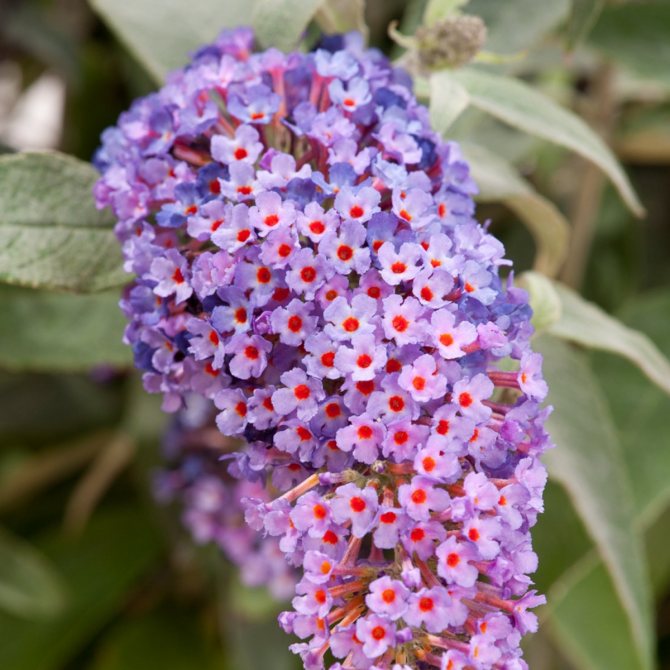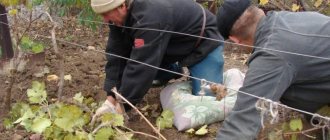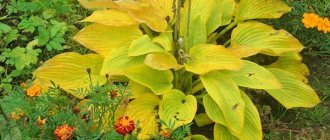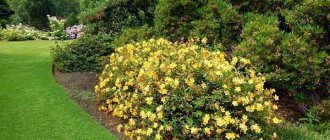Planting and caring for a budley in the Moscow region differs from the agricultural technology in the southern regions. The plant enters the flowering phase in the fall, retains its decorative effect until the first frost. In warm climates, preparatory work for winter is minimal. To preserve the root system in a temperate climate, the culture needs a number of additional measures.

Features of care in the fall and preparation for winter - general tips and tricks
All plants in the garden need care before winter, autumn care is especially important for plants that have migrated from other countries, which are poorly adapted to the weather conditions of our country. What does autumn care and preparation for winter include?
Watering. A shrub can do without watering for a long time, since nature has endowed it with excellent drought resistance. Under the condition of dry autumn, buddley is periodically watered with settled water. The next watering is carried out after the earthen coma dries. If the soil is dry on the eve of cold weather, the trunk circle of the bush is well moistened.
Important! Do not water the shrub too often: constant exposure to a humid environment will lead to the death of the plant.
Top dressing. In order for the buddleya to prepare for winter, the last time the plant is fed with fertilizers with a high content of phosphorus and potassium before flowering. In the future, the bush is not pampered with top dressing: such a hunger strike is designed to stimulate the plant to begin preparing for winter.
Mulching. Akin to most plants, the buddley tree trunk circle is insulated with a layer of peat, rotted manure or dry leaves. A layer of dry materials will protect the roots from frost and moisture evaporation. The soil is mulched immediately before starting work on sheltering the bush for the winter.


Pruning. Unlike most shrubs familiar to our country, instead of thinning the crown, the buddley is cut under a stump. Thanks to this pruning scheme, it is possible to grow plants even in the northern regions, since the 20 cm high shoot is easy to cover.
Shelter. By far the most important part of buddleya care in the fall is shelter for the winter. Since any manipulation will be in vain if the tropical plant is not properly covered. Before winter, both young and old buddley bushes need to be insulated. In the first case, the plant has not yet matured and has not adapted, in the second, the shrub is endowed with the ability to reduce frost resistance in adulthood. Since all varieties grown in our country are endowed with average winter hardiness, the optimal shelter method is chosen based on the weather conditions of the region.
Video: preparing buddleya for winter
Plant care
Reproduction of budley
Hatiora 130 photos of a cactus, tips for care and reproduction at home. Plant transplant and watering rules
It is worth considering that this shrub does not tolerate winter very well. Therefore, in the middle zone of our country, it is worth carefully covering the budley with humus or peat mixtures. But we do not refuse to care for roses, which need a more careful approach.
Budlea multiplies very quickly both with the help of seeds and cuttings.
If the seeds have matured enough, then they should be planted at the beginning of summer so that they will get stronger by the winter period.And in just a year, it will already be possible to see beautiful inflorescences on new shrubs.
It is also important that as soon as you have planted seeds or cuttings in the soil, they need to be marked under glass or polyethylene. The greenhouse effect will help the plant to get stronger and grow faster.
Resourceful housewives came up with the idea of placing plants under plastic bottles, by the way, the effect is exactly the same.
Remember! Cuttings should be planted in the ground only after they have sprouted.
Flowering budley
This shrub is called the autumn lilac. Thanks to its amazing aroma, it attracts a huge number of butterflies. So you can admire not only the beauty of the plant, but also another miracle of nature.
After planting cuttings, budlea begins to release inflorescences only in the fourth year of its life. What can not be said about planting seeds. Of these, just a year later, you can already observe the first flowering in early autumn and before the onset of cold weather.
Whoever saw how budlea blooms can say that this is one of the most charming flowers. Sultans can be up to 50 cm in length, making your garden even more attractive.
Few shrubs can boast that they begin to throw out sultans closer to autumn, or even in October, which will make your garden brighter, since many plants will no longer bloom at this time.
Warming and preparation for winter
You should also pay attention to this nuance, since budleya does not tolerate winter very well.
- When the shrub blooms and the branches begin to dry, it means it's time to think about insulation. Many housewives do not prune branches until they are completely dry. Here you can do it at your discretion. Who wants to enjoy more greenery before winter - leave. Budleia branches should be cut 10-15 cm above the soil level. Don't worry, next year it will grow the same.
- After all the branches have been removed, insulate the "leftovers" with peat or humus. This is the best way to get through the winter. Do not be afraid if the stems freeze a little during the winter. The shrub is very easygoing and will quickly recuperate with your help. Well, you will be helping him from the spring with organic and mineral fertilizers.
- In winter, watering and covering it is not necessary. There is enough snow in the winter. But if you cover it, it can sprout out shoots, which will disappear in severe frosts, which will affect the whole week in spring.
Pests and the fight against them
By itself, budlea is resistant to various diseases. But some parasites can still get to your bush.
- Spider mite (it appears when the air is very dry). In this case, you should immediately cleanse the plant from the disease with the help of medical alcohol (without diluting it in anything), and once a day spray the entire shrub with water from a spray bottle. This way you can get rid of both the tick and the unhealthy look of your budley. Just do not overdo it with spraying, so that you do not have to treat Budley for gray rot. As soon as you notice an improvement, immediately begin to reduce the spray dose.
- Gray rot (appears, on the contrary, from excessive moisture). If this is due to weather conditions, try to protect the bush from excess water. For example, a shallow canopy over a bush. If it was possible to get rid of the tick with the help of water procedures, then in this situation it is much more difficult to cure the plant. It can just start to rot and disappear.
As a result, after reading this article, it became clear that it was a picky shrub. But on the other hand, in order for it to grow even more beautiful, more careful care is needed.
However, as with the rest of the flowers in your garden. Top dressing is needed in the summer (that's when you start planting budley in open ground). There are not so many pests in the plant, and the budlea itself is resistant to them, which makes it easier to care for it.
Pruning in the fall
Regularly removing branches is very important for a fast growing plant like buddleya. By timely carrying out autumn pruning, you can achieve the most abundant flowering from the plant.
Why crop
With the arrival of autumn, a whole mountain of affairs falls on the shoulders of the gardener, since every plant in the garden requires care. Before pruning their favorite perennial flowers and shrubs, each owner involuntarily has doubts whether such an intervention will harm before winter and whether it is advisable to cut this or that plant.
To allay any concerns about this, below are the reasons for regularly trimming the bush:
- Over time, buddlea stems stretch out and become bare. Such deformed shoots very much spoil the appearance of the bush. To restore the lost beauty to the plant, the branches must be shortened.
- Pruning "autumn lilac" stimulates abundant flowering.
- As a result of timely cutting off and shortening of shoots, the plant's immunity to diseases increases significantly, and winter hardiness improves.
- If the shrub on the site is grown as a hedge, the branches must be cut to give the plant the desired shape.
In view of the many functions that garden manipulation carries in itself, autumn pruning is simply necessary for the normal development and beautiful appearance of the buddleya.
Pruning dates in the fall
Experts recommend pruning buddleya in the second half of autumn, because thanks to pruning during this period, the shrub is much easier to cover for the winter, which is very important for a thermophilic plant in the central, and even more so, northern regions of Russia.
You can start removing branches immediately after blackening the leaves. Depending on the care provided during the season and the weather conditions, this time comes in October-November.
How to properly trim buddley in autumn - instructions and diagram
In order for the shrub to not suffer from autumn pruning, but to get the maximum benefit, it is necessary to thoroughly understand the manipulation technology. In the Moscow region, buddleya is cultivated as a shrub: all shoots completely freeze out in winter, and upon the arrival of heat, the plant forms new shoots, which by autumn increase in lengths of 1.5-2 m and bloom.
Due to this feature, the algorithm for trimming buddley in autumn looks like this:
- After the end of flowering, faded yellowed inflorescences are cut from the bush, which greatly spoils the appearance of the bush.
- Shoots are cut with a sharp tool, leaving a stump 20 cm high.
Such a major pruning simplifies the shelter of the bush for the winter and does not harm the buddley at all.
Care after pruning
After cutting, the flowering shrub does not require any special care. All that is needed is to remove the cut branches and take them out of the site. As mentioned above, no fertilizer is applied to the plant in the fall.
Application of budley in landscape design
The homeland of the plant is China, where it is known as an evergreen shrub. In Russia, buddlea sheds foliage when winter frosts come. Outwardly, the plant looks like a tall (up to 3 m) spreading bush, with pointed oval leaf plates. The shrub owes its decorative effect to beautiful inflorescences.
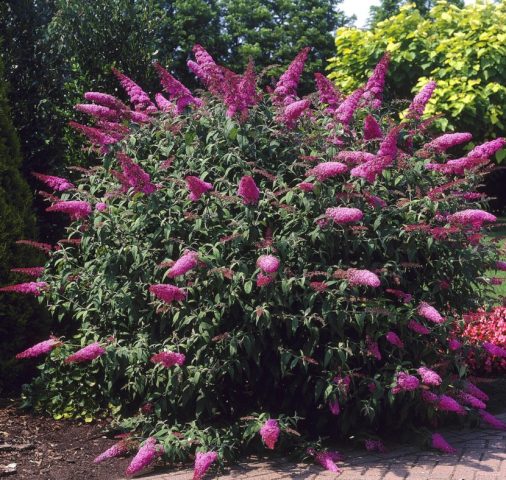

The beauty of a buddleya can be judged from a photo in order to make a decision about its use in landscape design. The shrub is decorative already in spring: the upper part of the leaf plates of the plant is dark green in color, and the lower one is of a gray, velvety tone.
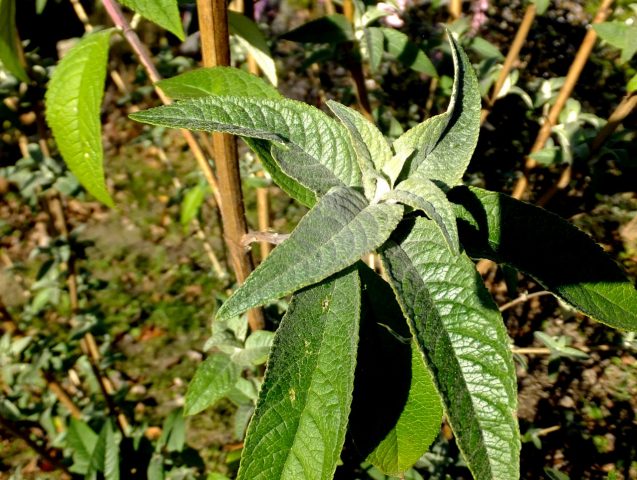

They use budley both in group and single compositions, focusing on the size of the site and the plan. Often, several varieties of shrubs are combined with different shades.
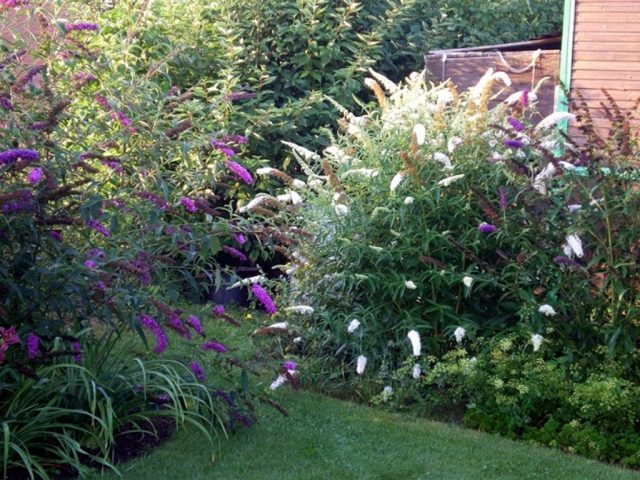

A plant with habitus or other perennials: representatives of conifers, roses or hydrangea are harmoniously combined in flower beds.
You can appreciate the shrub of David's buddley from a photo showing the use of a plant for zoning a site, or as a hedge. Designers grow buddley as a kadka culture, placing it on terraces and balconies.


A variety of varieties of Buddley David allows you to choose the best option for your site.
- Flower Power'R: Known among gardeners for its two-tone color. The inflorescences of the variety are very dense, fluffy, in the form of an ear, reaching 40 cm in length. The color of buddley buds is orange-purple. Tall shrub (2-3 m).
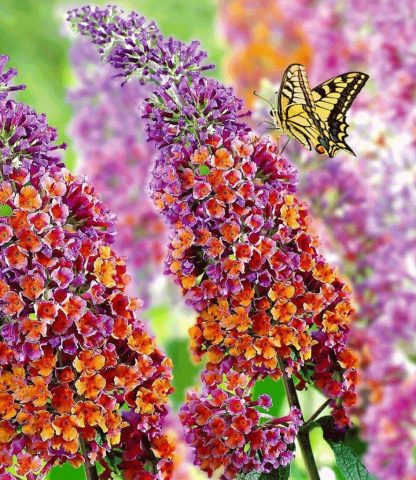

- Black Knight is distinguished by an unusual dark purple color with yellow blotches in the center. The shade of the buddleya is very rich, it stands out favorably against the background of silvery leaves. Shrub 1.5-2 m tall, branches are spreading, slightly drooping.
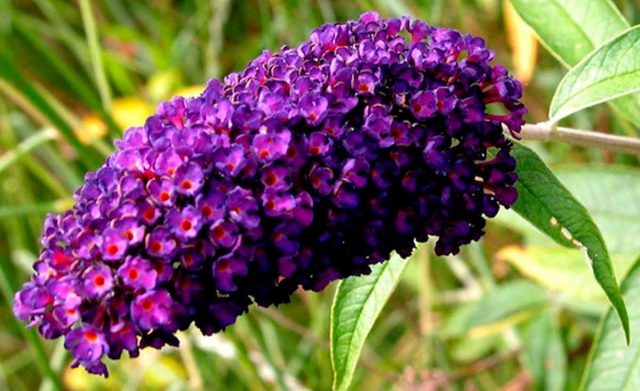

- Blue Chip is a compact buddleya, reaching 45-60 cm in height and 90 cm in diameter. The variety is used for cultivation in containers. The inflorescences of the shrub have a bluish-purple hue, bloom from July to October.
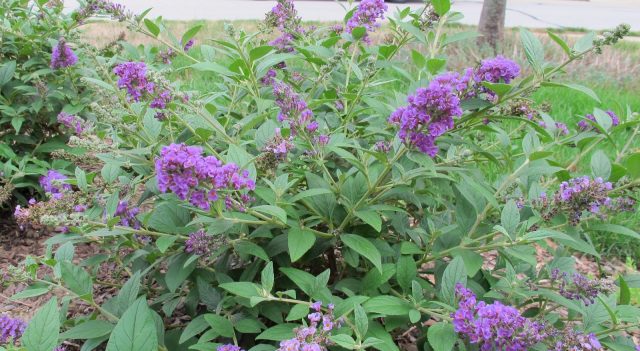

- Royal Red differs from other varieties in purple-scarlet flowers, collected in large inflorescences, 25-35 cm long. The buddlei shrub grows up to 3.5 m in height, differs in spreading (2.5-3.5 m).


- White Bouquet is known as a white-flowered variety. Unlike other representatives of David's buddleia, it has more abundant inflorescences. The panicles of the shrub are spike-shaped, fluffy, up to 20 cm long. White Bouquet grows up to 3 m in height, has lanceolate, dark green leaf plates. The White Profusion buddley variety has a similar color shade and characteristics.


- Flutterby, which reaches a height of 60 cm, is popular among compact buddlei varieties. The culture blooms all summer and autumn months before the onset of frost, tolerates low temperatures well (up to -25 ° C). Used buddley for growing in pots. The bushes have gray-blue foliage and lilac inflorescences. The buddlei variety is not seed propagated.


Shelter for the winter
In order for the plants growing in the garden to be able to endure prolonged cold without consequences, they must be covered. This is especially true for thermophilic exotics, which are not initially endowed with high frost resistance, such as buddleya. Before proceeding with the insulation, you will need to acquire a wooden box or dense material and arcs, as well as mulching material.
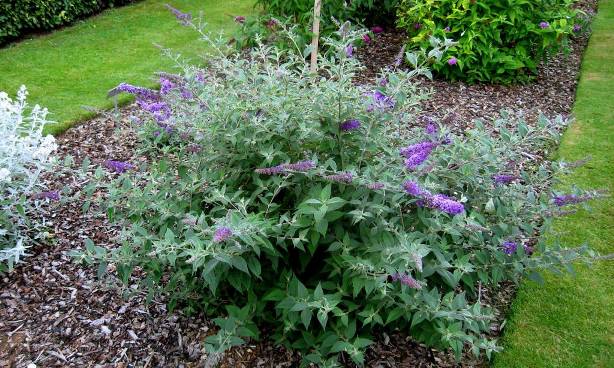

It is worth noting that according to the opinion of experienced flower growers who have been cultivating buddlei for a long time, bushes grown from seeds winter several times better than those bought in a store.
Do I need to shelter for the winter
Due to the fact that under natural conditions buddlei grows in the tropics and subtropics, the bush must be carefully covered for the winter, since a temperature drop to -20 C entails freezing of the shoots, and when the frost is more than -20 C, the bush freezes.
How to properly cover for the winter
Insulation of bushes for the winter can be done only after the buddleya enters a state of rest and the establishment of dry, calm weather. Please note that covering wet branches will lead to damping and death of the plant.
One-year-old buddlea saplings are still very weak to withstand the harsh winter even under a thick layer of shelter. To be completely sure of their safety, young bushes are carefully dug up and, together with an earthen clod, are placed in a container and transferred to the basement.
Adult buddleys are sheltered for the winter in several ways:
The first way. As soon as the leaves of the autumn lilac have turned black, the trunk up to the 3rd bud is covered with dry soil. A wooden box or other container according to the size of the plant is installed on top of the embankment and covered with slate, roofing material. During the winter, snow is poured onto the shelter. In this way, it is preferable to shelter the buddley in the northern regions.
Important! In this method of shelter, polyethylene and wood chips should not be taken, since the use of these materials can lead to fading.
Second option shelter buddleya is a construction of a mini greenhouse. The trunk is covered with dry soil, and the trunk circle is mulched with peat or rotted manure. Then, on top of the plant, at a height of 30 cm, wooden or metal arcs are installed, which are covered with spunbond, lutrasil or film. If a strong cold snap is foreseen in winter, a layer of hay or dry leaves is laid on top of the structure.
Important! To saturate the plant with moisture and prevent rapid freezing of the soil, the day before the establishment of the shelter, the buddley is watered abundantly
If, despite the efforts made, your favorite shrub froze a little, do not despair, buddleya will quickly recover and bloom again. However, it should be borne in mind that with age, the bush gradually loses its original frost resistance and ability to regenerate, which is why an adult plant often dies even from slight frosts if it was poorly insulated.
Video: how to cover a buddley for the winter
Reproduction and planting of budley
Growing bacopa from seeds
Budleia can be grown from cuttings that root easily throughout the growing season. And you can buy already rooted cuttings of different varieties and flowers of budley, or from seeds.
It is necessary to take a wide and shallow dish with holes in the bottom, make good drainage, embankments of good loose soil, preferably sifted, so that you can see when the first shoots appear ... Next, mix the seeds with sand in order to better distribute over the soil surface and barely sprinkle, lightly tamp with a board and sprinkle with water from a spray bottle. After that, cover the vessel with glass or a plastic bag and put it in a warm place (20-25 degrees), and after two weeks, small budleys will begin to sprout.
Of course, periodically you need to moisten the earth, but not too much. And when the plants come, take off the bag or glass and put it in a well-lit place, but preferably not in the sun, to which the kids need to be taught gradually, like any seedlings. When the sprouts have 2-3 pairs of leaves, you should pick them up in separate pots and grow them, and then plant them directly in the ground, or in pots where they will grow further. And already in the fall you can see their first bloom. But do not get too carried away, and it is better to cut off the first buds, let the bush develop. But even if you don’t do that, it’s still developing well and quickly.
I described this method of growing budley from seeds - for those who love the process of growing plants.
What exactly causes admiration for this plant? And why is it popularly nicknamed "the moth tree?" When I saw the wake for the first time, I stopped fascinated. From under the covers of the moth wings, purple budley flowers, collected in dense inflorescences, shone (that was exactly the budley of this color). When I came closer, a whole fireworks of butterflies fell from the bush and circled over my head. But the bees did not even think to leave their work - to collect honey of sweetly fragrant flowers ... After all, the heady lilac aroma of budley filled the whole garden.
My first budley is purple. And after a few months from the catalogs, I learned that they come in different colors, except for yellow, orange and bright red. That is, the whole gamut of violet-blue, violet-reddish, with red centers, white, pink. Subsequently, as I said, several more multi-colored budlias were grown from the seeds. A few more shades were acquired from familiar florists. Now my first budleya is a beautiful vast bush, up to 3 meters in height and densely covered with large bright inflorescences.
What are the features of preparing for winter in the regions
After completing the preparatory work, you need to decide on the most suitable method of shelter.Depending on the weather in the region of growth, the buddleya is covered in different ways. The main condition for proper shelter is that the height of the air cushion and the thickness of the mulching material should increase with decreasing temperature.
In the middle lane
In the central regions of Russia and the Moscow region, to protect the buddley from the cold, it is recommended to install a film greenhouse over the plant. The detailed arrangement of such a shelter for the winter is described above.
In the Volga region
The optimal shelter for shrubs in the Volga region is a film greenhouse, on top of which a layer of mulch made of dense materials is laid or hemp is covered with spruce branches and a box is installed.
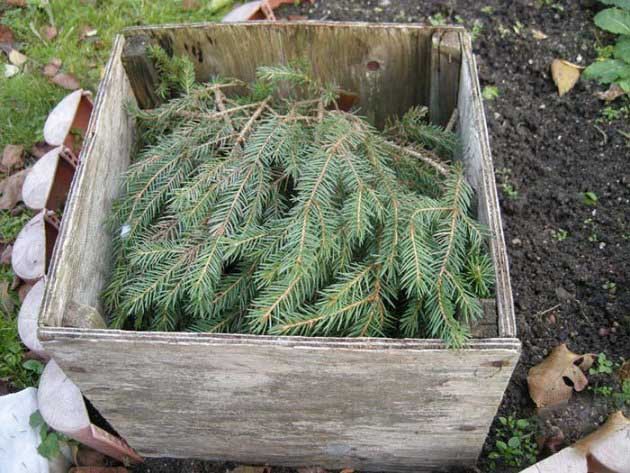

In the Urals and Siberia
To protect the thermophilic plant from the northern cold, a bag of sawdust is poured over the prepared bush. A plant sheltered for the winter in this way perfectly tolerates winter only in the Urals and Siberia; in most warm regions, wood chips accumulate water after thaws and cause kidney decay.
Typical mistakes of care in the fall and preparation for winter
Even during the cultivation of frost-resistant flowers and shrubs, mistakes happen, let alone the cultivation of exotic plants that require the creation of certain conditions. After reviewing the list of the most common misconceptions, you will be able to prevent them from happening on your site.
Some of the most common mistakes in grooming and preparing a buddleya for winter include the following:
- The shrub is incorrectly covered, as a result of which the root collar is blown out or the buds rot.
- In the event of a prolonged thaw, they do not open the shelters: under the influence of heat, the stump of the stems vomits out.
- In the fall, the plant is fed. As a result of the entry of nutrients into the soil after the end of flowering, the transition of the plant to a state of dormancy is delayed.


Growing heat-loving plants in the middle lane is a rather difficult task, but, in principle, doable. To surprise guests with a flowering plant, which has flocked to dozens of butterflies, you must unquestioningly follow the recommendations for autumn care and properly prepare the buddley for winter. Particular attention should be paid to the shelter, since the frosts of the middle lane are destructive for the thermophilic shrub.
Budlea resembles lilacs during flowering. A tall bush, strewn with bright, fragrant bunches of flowers. A native of warm regions has taken root in Russia, with proper care, planting is possible in open ground.
Frost-resistant budley varieties
Budleya is called "oriental beauty" for a reason. The countries of warm latitudes are considered its homeland, so it is not surprising that the plant feels most comfortable in the southern regions. However, it is also quite possible to grow a budley in a summer cottage in the Russian climate with proper care and proper attention.
Since buddleya has gained popularity far beyond the subtropical zone, breeders regularly develop new varieties that can delight the eyes of those who live in less hospitable climates.
The most frost-resistant plant varieties include:
- Buddley David in particular Empire Blue, White Profusion, Pink Delight and Royal Red varieties;
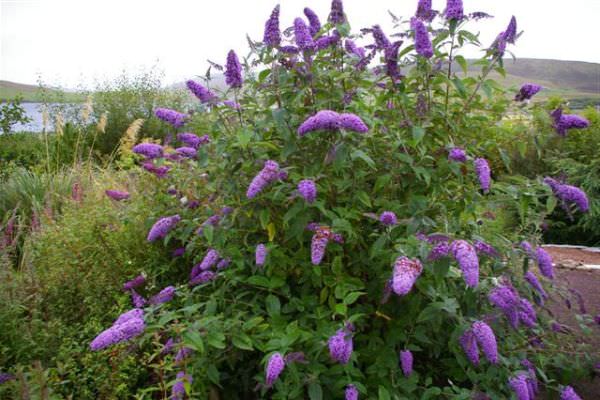

- Budley Vich;
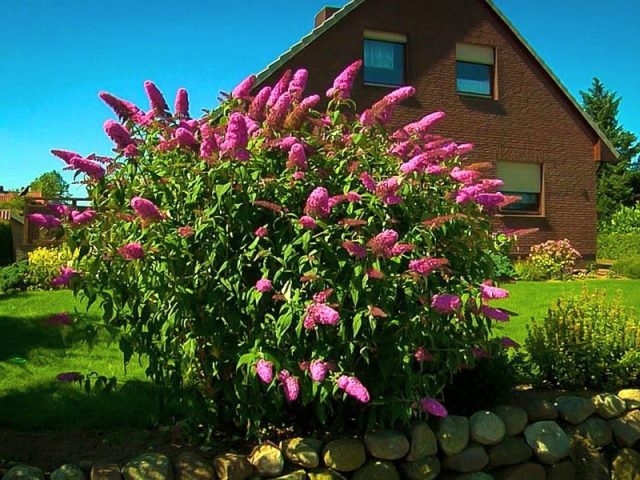

- Budley Wilson.
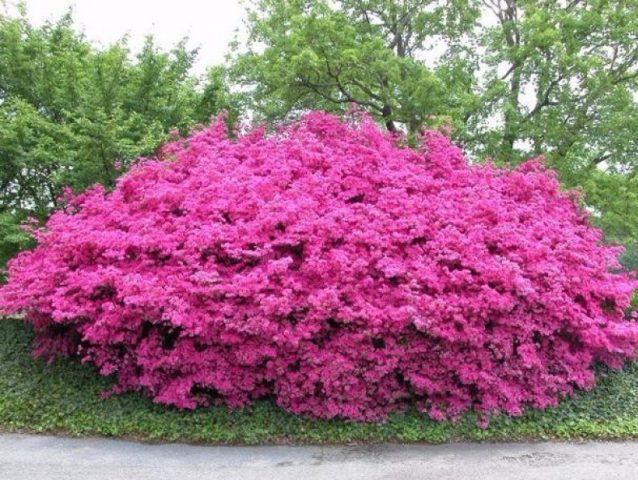

They are able to withstand frosts down to -23 ° C.
In addition, among the variety of species, representatives with an average winter hardiness are distinguished, including:
- Japanese Budleya;
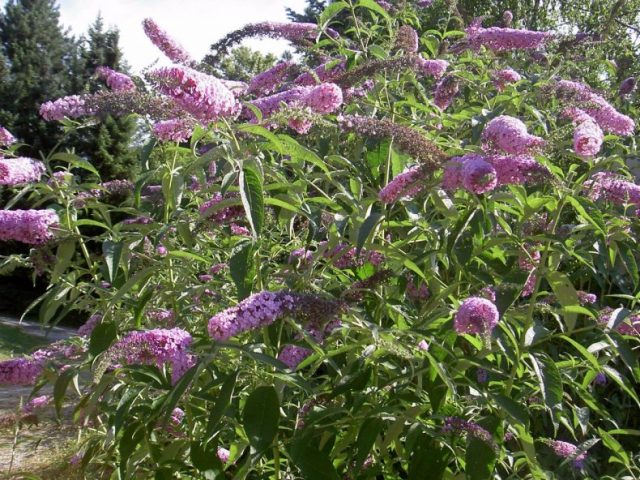

- White-flowered budley.
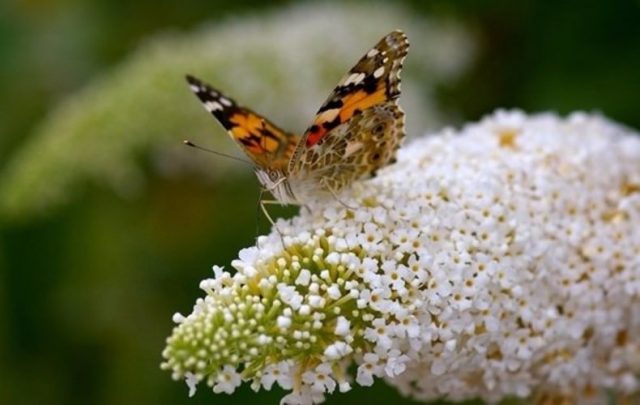

Is it possible to grow a budley in a summer cottage?
When planting a budley, one must remember to observe the conditions for planting and wintering the plant. Only in this case it is possible to grow a budleya in central Russia.
Disembarkation requirements:
- good lighting, no shading;
- lack of drafts and strong winds;
- without the possibility of waterlogging the soil.
In these cases, the bush gives good shoot growth and abundant flowering.
With proper care, budlea grows very bushy.
How to properly plant a buddley in open ground?
Buddleya is a sprawling shrub that requires a lot of free space when planted outdoors. At a distance of 2 m from the plant no need to plant other plants... Do not plant it close to a fence or building.
Planting time is the end of March, before the leaves begin to bloom.
For the bush, it is necessary to prepare a planting pit with a diameter of 40 cm and a depth depending on the size of the root.
The bottom layer of the pit is 15 cm of drainage. The next layer (15 cm) is a mixture of fertile soil with fertilizer in the form of a mound.
Plant roots spread over the second layer and sprinkle with earth, tamping slightly. The root collar should be at ground level.
Then the basal circle is watered and mulched with peat or other material.
For planting a budley, a pit with a minimum width of 40 cm is required
Reproduction of buddleya
Christmas flower poinsettia home care
Buddleya David can reproduce both by seeds and cuttings.
Propagation by cuttings
It is easy to propagate buddleya by cuttings in July-September. Cuttings are cut after the flowering of the bush. Each stalk should have 3 to 4 buds. Cuttings are taken semi-lignified with two internodes or green. Then they need to be treated with heteroauxin. After processing, the cuttings are planted in a box with coarse river sand and covered with glass. It is not necessary to cover with glass in a warm room.
During the day, you need to spray with warm water and moisten the sand from time to time. With early cuttings and favorable weather conditions, young plants bloom in the same year.
Planting cuttings of Buddley David can be done immediately in the garden or vegetable garden. In the ground, you need to make a small hole, lower the stalk with the buds there and cover it with earth. For the winter, seedlings need to be covered, as well as adult bushes. When spring begins and the ground warms up well, cuttings will begin to grow. You need to take care of them in the same way as for adult bushes.
Seed propagation
Buddleya grows beautifully, blooms and gives seeds. Seeds can be sown in January in an 8 cm pot with moist soil
Watering must first be done from the pallet, and then very carefully spray from above from the spray bottle
After the appearance of 4-5 leaves, we cut the seedlings into a box. Before planting in the ground, you need to water the plants twice with a weak solution of potassium permanganate and twice with a solution of micronutrient fertilizer.
For sowing and picking, you need to take a mixture of turf and peat (3: 1). In early June, we plant the seedlings in the ground at a distance of 0.5 m. In the first year, the bushes will reach a height of 60-70cm, but they will not bloom. Before the onset of cold weather, the stems need to be cut to 30 cm, spud and insulate the plants.
In the middle of May next year, we remove the insulation, uncook the bushes, and at the beginning of June we plant them in a permanent place and fertilize with infusion of pigeon droppings (1: 100). The buddleya begins to bloom in the second half of July and lasts until October. Inflorescences are from 25 to 50 cm in length, with 25 cm more lush.
In the garden, the buddley should be placed in groups or individual bushes. Her bushes look wonderful in the garden next to other decorative undersized bushes.
Healthy and elegant Buddleya David will decorate your garden and give you a lot of indescribable moments of relaxation. I sincerely advise you to plant these wonderful bushes in your garden.
Read Business Gardening and study with us!
Send to your social network so as not to lose:
Leaving immediately after planting
After landing, budley need to cut:
- remove weak and dry branches;
- shorten healthy shoots per bud by 1/3.
This is how skeletal branches are formed, which will give shape to the bush.
In the spring, immediately after the awakening of the kidneys nitrogen fertilizers are applied... During the flowering period - phosphorus-potassium fertilizers or rotted manure with ash.
Budleia tolerates drought better than waterlogging, so watering should be moderate.
In extreme heat, it is required to moisten the crown of the bush.Budley blooms for several months. On the bush there are both flowering and fading clusters at the same time.
Removing fading flowers will prolong the flowering of the bush and improve its decor.
Withered budleia flowers must be removed
Do I need to cover flowers for the winter and how?
Winter period with temperatures below 20 degrees will lead to freezing of shrubs... To preserve the shoots, you need shelter for the period of cold weather.
Young bushes especially need to be insulated. They can freeze out. Mature plants are more hardy, but they also freeze under the autumn-winter cold.
Frost-damaged shoots are removed in spring. During the spring, the bush grows back and gains color on young twigs.
It is necessary to completely cover the budley: from root to top... For this, a frame is installed on which a double protective layer of material is stretched: insulating and water-windproof.
Bushes are cut for the winter:
- in the young, 3 buds are left above the soil (20 cm);
- 2-5 years old - by a third.
Pruning does not harm the plant as it has a strong shoot regeneration ability.
How to propagate budley
Reproduction of budleya is possible in two ways. Each of them has its own right to use.
Seed propagation
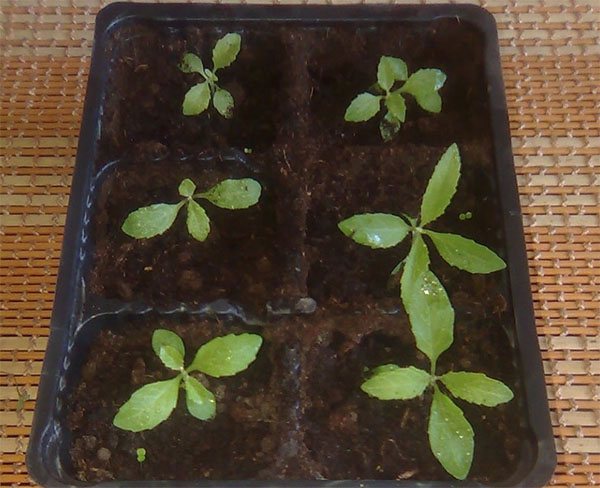

This is a very time consuming method. The seeds can be bought at a specialty store or harvested from a bush in late autumn. But whether the seeds collected with their own hands will sprout depends on whether they ripened well enough. The fact is that, for example, planting a budley and leaving in Siberia in the open field behind it is possible. But seeds in cold climates do not have enough time to ripen. Therefore, it is better to give preference to purchased seeds.
The soil used for sowing must be neutral in acidity. The seeds, since they are very small, are best mixed with sand. They are sown on loose soil and slightly nestle. The container is covered with foil or glass. Watering is done with a spray bottle. The container is placed in a warm and bright place.
The planting material should be regularly ventilated and moistened. The first shoots appear on days 14-21. At the stage of appearance of 3-4 leaves, the seedlings dive into separate pots. Only with the onset of persistent heat in the spring begins planting and caring for budley in the ground in the open air.
Propagation by cuttings
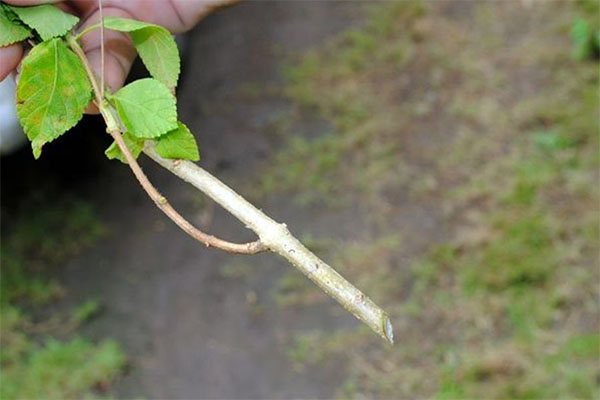

For propagation by cuttings, you can use young spring shoots 15-20 centimeters long or woody twigs cut in the fall. On the cuttings, the lower buds are removed and treated with a growth stimulant. The twigs are buried 3-5 cm in the ground and covered with foil. Rooting takes place over two months. The film is removed only after the appearance of new shoots.
Regardless of which method of plant propagation is chosen, the first stages of germination and rooting are best done at home. Planting and caring for a budley in the open field is possible only after the onset of warmth.
Warming methods
The frame can be metal, wooden. Polyethylene is suitable for protection from rain and wind. For insulation - any non-woven fabric.
Inside the protective device a dry leaf is laid for better insulation and protection from excessive moisture.
Insulation in the form of straw, dry peat, leaf is laid on the base of the root. The whole structure is fixed to the ground with something heavy so that it will not be blown away by the wind.
In spring, the shelter is removed as soon as the temperature rises above -10 degrees... Root protection remains up to freezing temperatures.
Sawdust should not be used as filler in the protective device.
The most popular varieties for the Moscow region that tolerate frost well
Out of 160 varieties of shrubs, Budlei, Ordinary-leaved, David, Vich, Wilson, as well as Belotsvetkovaya and Snezhnaya have acclimatized in Russia.
David
Budleya David grows up in the conditions of the Moscow region and the Urals up to 2-3 m... It has large bicolor leaves up to 20 cm in length and spike-shaped inflorescences (up to 40 cm).
The flowers are lilac, with a honey smell. The flowering period is from late July to September. Has varieties that differ in color of flowers:
- Alba, White Cloud, White Profusion - white;
- Empire Blue, Black Knight - purple tones;
- Harlequin, Royal Red - shades of red.
Wilson
Wilson's Budley resembles a weeping willow. Blooms from mid-August to late September lilac-pink inflorescences up to 75 cm.
Wilson
Vicha
Budleya Vicha blooms in early August in large, rich pink inflorescences.
White-flowered
Budleya Belotsvetkova bush has pyramidal vertical inflorescences with small white flowers.
White-flowered
Snowy
At Budla Snow, the leaves, branches and flowers are covered with the smallest thick hairs that resemble felt. Lilac inflorescences are small, paniculate.
A warm and light-loving plant can be grown in conditions of low winter temperatures and return frosts. Strong annual growth shoots compensates for the freezing of the bush in winter.
Snowy
Proper planting and care, timely pruning and covering for the winter will create the right conditions for the growth and flowering of budleia.
This is a guest from China on our sites, which is often referred to as "autumn lilac". The plant is spectacular and I want to keep it in the winter in order to admire the flowering next season. Pleasant news for gardeners will be the fact that it is quite easy to keep a budley in winter, since in warm regions it perfectly survives this time even without shelter. But even with such excellent indicators, the plant will have to be prepared somewhat.
Pruning budley for the winter
If you live in a warm strip, you cannot do without pruning. Here it is important not just to make cuts correctly. The fact is that the success of wintering is also influenced by the literacy of planting the bush initially. A three-year-old bush should get to its permanent place in April-May. Younger bushes hibernate in tubs of soil in the basement.
From about the end of June, potassium-phosphorus fertilizers are applied under the bush. As soon as blackening of the foliage is noticed on the bush, it should be cut off at a distance of about 20 cm from the ground. Preparing adult budleia bushes for winter begins in October after the pruning has been done almost to the root: the plantings are well watered and then spud every other day.
How to cover a budley for the winter?
Next, let's move on to a more detailed consideration of the issue of how to cover a budley for the winter. We will also dwell on some controversial points. After pruning, the bushes are spud with one of the methods that we will consider below. And then opinions differ. Gardeners use three main methods of preparing a budley for winter:
- All are equally huddled only with dry soil. Then there is the option to use boxes, which will then be covered with a layer of snow. Instead of wooden boxes, you can safely use pieces of slate or similar material. Your goal is to get an air gap between the dirt embankment and the snow. The fact is that even such a shelter does not give you a guarantee of a successful wintering for a bush. Young plants and ornamental varieties are afraid of spring frosts. And a warm winter can also be dangerous, when at first a lot of snow falls, then it begins to melt. This will lead to wetting of the soil and rotting of the buds of the bush in the shelter.
- That is why there is a different opinion regarding the care of the budley for the winter. The pruning scheme and the hilling principle are no different. But instead of slate or boxes, some gardeners prefer to use iron arcs. A film or spunbond or other covering material is stretched over these arcs, and snow falls on top of it. You will get something remotely similar to a greenhouse. For the middle lane, the height of the arches reaches about 30 cm, and for colder regions it is up to 40 cm. Thus, we get a large air gap and keep heat for the plant.
- There is a third option for preparing a budley for winter, but it is suitable only for the coldest regions.It consists in the fact that after pruning and watering, you do not need to cover the bush with soil, but use sawdust. We simply pour about a bag of sawdust onto a prepared bush, and in mid-May, the sawdust is removed, and the plant starts growing successfully. But this method is only for cold regions, since in warm climates, sawdust contributes to the accumulation of moisture and rotting of the kidneys.
Thus, caring for a winter budley is reduced to four main stages. First we feed the plant, then prune it properly and water it. Next, we should choose the type of hilling (sawdust or soil) and the method of covering. It is difficult to say what exactly will be the ideal solution for you, but the goal remains the same: to prevent overheating. And this is achieved by the correct height of the embankment and the size of the air cushion. And by the way, a plant grown from seeds adapts much better to cold weather and hibernates without loss.
Here's how to prepare your buddley for winter quickly and easily. Recently, the shrub has become more and more popular among our gardeners and not only in the south.
The popularity of the buddley is held back by its low winter hardiness; in our climatic conditions, it often freezes out in winter.
Rules for growing buddleya in the Moscow region
The agricultural technology of the buddleya in the Moscow region does not differ from the care of the culture in the southern regions, with the exception of autumn preparation. To preserve the decorativeness of the plant, it must be fed, watered, and weeds removed from the site.
Budleya is drought-resistant, can do without watering for a long time. But it reacts badly to dry air, flowers and leaves turn yellow, then dry, frequent sprinkling is necessary. Watering is required for a young seedling to a greater extent. Activities are determined by seasonal precipitation. If it rained 2 times a week, this is enough for the seedling, but in dry weather the moisture deficit is supplemented by watering.
For an adult plant, one watering every 14 days is enough, the root system of a buddlea is superficial, a constantly moistened root circle can cause the development of a fungal infection. The climatic conditions in the Moscow region are unstable, a sharp change in temperature at night and during the day has a bad effect on the weekday if the soil is constantly wet.
Loosening the crop as weeds appear. Loosening is carried out in a thin layer so as not to damage the root. Top dressing is applied in spring, using superphosphate ("Kemira Universal"). Fertilize in autumn before preparing for wintering.
Budleia pruning is carried out in the fall, the crown is completely cut off, if conditions allow you to cover the budleia for the winter and not subject it to cardinal pruning. In the spring, frozen, weak branches are removed, the length of the shoots is shortened at will. Mulch budley immediately after planting and without fail in the fall.
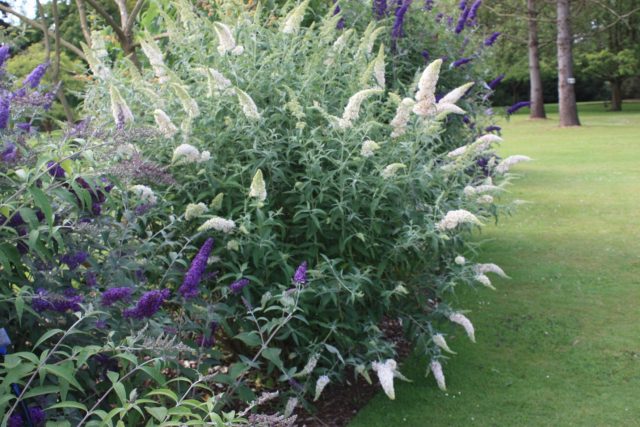

How to prepare a buddley for winter:
The shrub resembles lilacs with its lush inflorescences, and because of this it received the name "autumn lilac" among the people. Buddleya has a very pleasant and strong aroma, which is especially attractive to butterflies.
The most popular species from the more hardy plants are David's buddley (decorative forms - Wilson, Vich and varieties - "Nanho Purple", "Royal Red", "Pink Delight" and "White Profusion").
Less hardy species, suitable for the southern regions: Japanese buddleya, buddleya alternate-leaved and white-flowered buddleya.
Plants are planted in a permanent place only 2-3 years old. Until this moment, it is grown in containers with a soil mixture: turf soil, sand and leafy earth (humus) in a ratio of 1: 2: 2.
YOUNG BUDDLEY
For the winter, the young bush is transferred to the basement (cellar), and in April-May it is taken out into the garden. At the end of June, it is fed with phosphorus-potassium fertilizers (ash). When the leaves begin to turn black on the bud, it is cut off at a level of 15-20 cm from the ground.
ADULT BUDDLEY
Adult bushes in October-November are watered abundantly and the next day they are spud. They sprinkle with dry soil, above the 3rd bud and cover with spruce branches, brushwood.Sometimes they additionally produce mulching with dry humus or peat.
Then a frame is made of iron arcs or a wooden box is taken, and the top is covered with slate, roofing felt or fiberglass.
- There are opposite opinions on the use of plastic wrap. Some gardeners recommend covering the arches or box with a double layer of film, and securing it tightly. It turns out a kind of greenhouse (greenhouse). Other experts advise against using film at all.
The editorial board of the Flower Festival believes that if you make arcs at a height of 30 cm (40 cm - for severe winters) from the ground and fix the film well, then the resulting air layer will contribute to the successful wintering of the budley, and the plant itself will not rot.
To improve the effect, the resulting greenhouse is covered with dry hay or leaves after the onset of stable frosty weather -8-10 degrees.
Such preparation of the budley for winter allows the plant not to freeze even during a harsh winter. The further north you live, the more you increase the amount of covering materials and the height of the air cushion for a successful winter.
- According to the observation of experienced flower growers, an important factor in a successful wintering is the type of buddleia cultivation. A plant grown from seeds is much less likely to die in winter than a plant bought in pots.
Budley "Royal red"
Is it worth planting or replanting budley in the fall
It is preferable to replant or plant in a permanent place in the spring. This plant has a taproot that goes deep into the ground, which is easy to damage during transplantation.
Important!
It is better not to touch the plant at all during this period. Transplanting a shrub in the fall is done only when absolutely necessary.
Preparation
For a budlea, it is important to choose a place closed from drafts with good lighting or light partial shade. The soil should periodically dry out, since the abundance of water on the site leads to rotting of the roots. For good development of a highly growing root system, plants should not be planted densely.
The transplant is performed as follows:
- The bush is dug out, trying to preserve the integrity of the roots as much as possible.
- A new planting hole is made, the size of which is twice the size of the root system.
- A 10 cm thick drainage layer is placed on the bottom.
- A little soil is poured, consisting of an equal amount of black soil, leafy earth and humus.
- The plant is placed in a pit, aligning the root collar with the soil level, and covered with prepared soil.
- Compact the soil around the trunk.
Post-transplant care
The transplanted plant is abundantly watered with settled lukewarm water. It is best to pour water into a groove dug around the plant. So, the root system is saturated with moisture more evenly. In the future, the plant is watered only after the soil has completely dried out.
Reproduction in autumn


For propagation of budlei in autumn, a vegetative method is used. Cuttings are harvested after pruning the plant and immediately planted in fertile soil in containers and stored in the basement. Periodically they are watered and ventilated. When the warm weather finally settles, the plants are transplanted to a permanent place.

